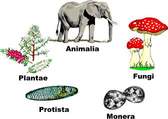- Southampton Middle School
- Classification (L.S. 5)
Edwards, Stephen (Grade 8 Physical Science Teacher)
Page Navigation
-
Classification Key Concepts

• Information about physical features and activities is arranged in a hierarchy of increasing specificity. The levels in the accepted hierarchy include kingdom, phylum, class, order, family, genus and species .
• As living things are constantly being investigated, new attributes are revealed that affect how organisms are placed in a standard classification system.
• This system is the basis for scientific nomenclature.
• Any grouping of organisms into kingdoms is based on several factors, including the p resence or absence of cellular structures such as the nucleus, mitochondria, or a cell wall; whether the organisms exist as single cells or are multi-cellular; and how the organisms get their food .For example, organisms that do not have a nucleus are believed to be fundamentally different from other organisms and may be classified in one or even two different kingdoms. Six different kingdoms of organisms are generally recognized by scientists today.
• Some important animal groups (phyla) are the cnidarians, mollusks, annelids, arthropods, echinoderms, and chordates .
• Four important plant groups are the mosses, ferns, conifers, and flowering plants .
• A group of similar-looking organisms that can interbreed under natural conditions and produce offspring that are capable of reproduction defines a species .
-
Files and Documents
 Classification Groups (Picture Perfect)
Classification Groups (Picture Perfect)
 Classification (Half a Minute 1)
Classification (Half a Minute 1)
 Plant and Animal Phyla (Challenge Board) ** HTML MODE
Plant and Animal Phyla (Challenge Board) ** HTML MODE
 Classification (Fling the Teacher)
Classification (Fling the Teacher)
 Classification (Half a Minute 2)
Classification (Half a Minute 2)
 Pamishan Creature Dichotomous Key
Pamishan Creature Dichotomous Key
 Coral Reef Fish Dichotomous Key
Coral Reef Fish Dichotomous Key
 Mythical Creatures Dichotomous Key
Mythical Creatures Dichotomous Key

